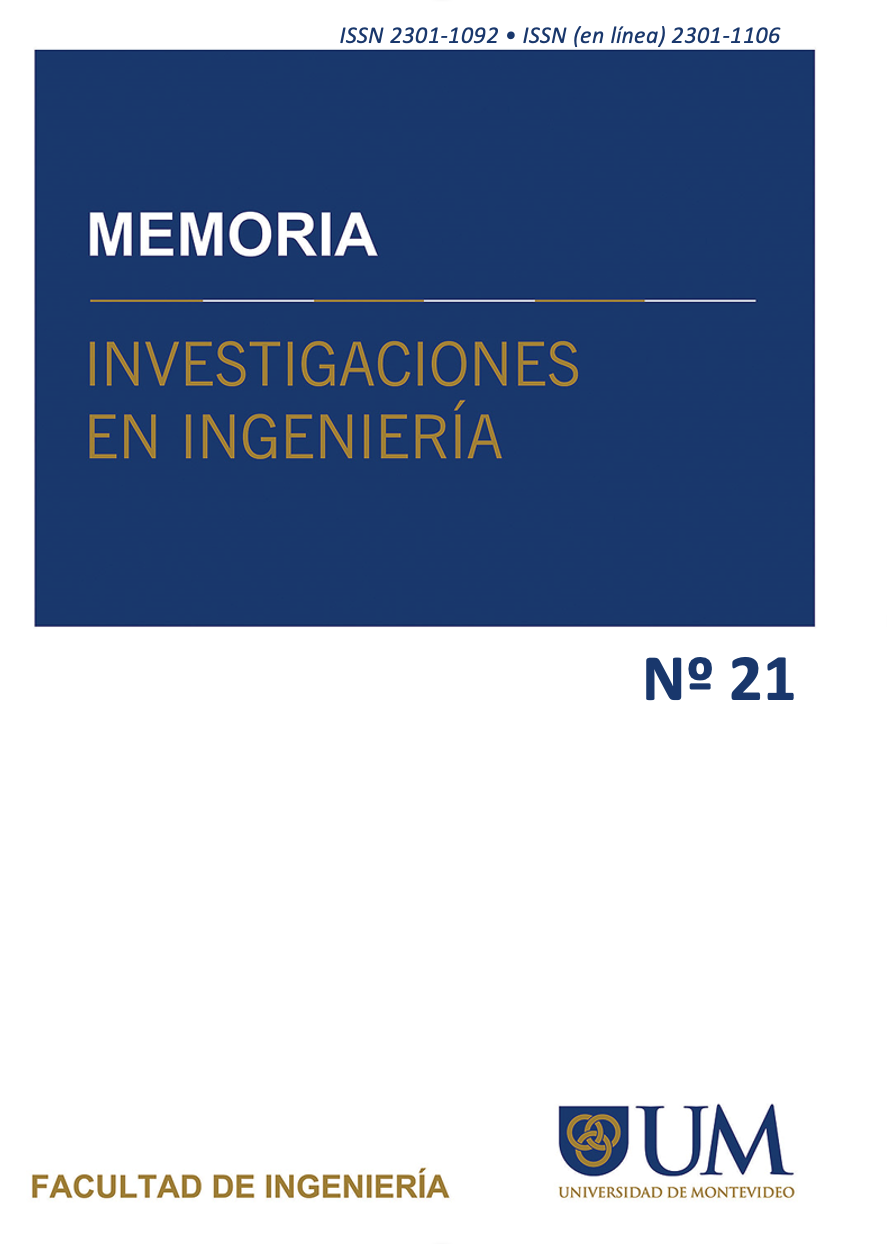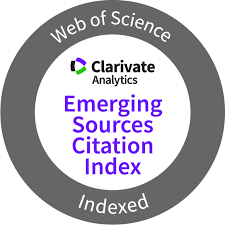Thermofluidodynamic simulation in a steel continuous casting mold
DOI:
https://doi.org/10.36561/ING.21.4Keywords:
Continuous Casting Mold, Steel, Solidification, ThermofluidodynamicAbstract
In the present study, a 3D multiphysics mathematical model was solved using the finite volumes method to predict the phenomena of fluid flow and heat transfer in a continuous casting mold of 20CrMnTi steel billets. The results showed the high cooling capacity of the system for the formation of a progressive and uniform solid layer that begins very close to the meniscus and reaches a thickness of 10 % of the section of the casting at the exit of the mold. At the exit of the SEN, the liquid steel underwent a reflux with a depth of 0.45 m measured from the meniscus. Some of the rising reflux reached the meniscus and descended, infiltrating the walls of the mold. Velocities less than 0.2 m/s, in the upper zone of the mold, and great penetration of the steel jet, in the center of the mold, were observed. It was concluded, based on what is described in the literature, the following: a) the thickness of the solidified crust, at the exit of the mold, is sufficient to avoid breakage in the piece due to the ferrostatic pressure exerted by the liquid steel, c) The fluid dynamic conditions that occur in the upper zone of the mold can be counterproductive for the transfer of heat in the meniscus and the dissipation of overheating in the steel.
Downloads
References
Y. González-Rondón, J. E. Rengel-Hernández, Comportamiento termo fluidodinámico del acero en un molde de colada continua: una revisión, TecnoLógicas, vol. 24, nro. 51, e1856, (2021)
J. Belisario, Evaluación de la efectividad del proceso de colada en la reducción de defectos de salpicaduras en las palanquillas producidas en la acería 150 TM de Sidor, Tesis de grado en ingeniería industrial. Universidad Nacional Experimental de Guayana, (2011).
A. Cruz, O. Hernández, A. Moreno y M. Vargas, Caracterización de fundentes para molde de colada continua de acero, Acta Universitaria, vol. 17, núm. 1, enero-abril. Universidad de Guanajuato, México, (2007). pp. 52-58.
V. Chang and P. Bolsaitis, Símplified model for heat transfer and solidification in continuous casting, Latin American Journal of Metallurgy and Materials, Vol. 2, N° 2, (1982).
M. Najera, Análisis del flujo de fluidos y transferencia de calor sobre la calidad de palanquillas de acero, Tesis de grado de doctor en ciencias en metalurgia y materiales, Instituto Politécnico Nacional, México, (2010).
C. Cicutti, Transferencia de calor en la colada continua de aceros, I parte, el molde, Revista Metalurgia, Madrid, (1977). pp. 333-344.
B. Pereira, J. Castro, A. Silva, y J. Duran, Modelado del proceso de colada continua de aceros libres de intersticios, Revista Información tecnológica, Vol. 21 No. 6, (2010).
J. Adilson, B. Amaral, R. Sampaio, E. Mendes and I. Leão, Numerical study of turbulent flows and heat transfer in coupled industrial-scale tundish of a continuous casting material in steel production, IntechOpen, Chapter 16, (2018).
K. Mills, P. Ramirez, P. Lee, B. Santillana, B. Thomas and R. Morales, Looking into continuous casting mould. Ironmaking and Steelmaking, Vol. 41 No. 42, (2014).
M. Tkadlečková, L. Válek, L. Socha, M. Saternus, J. Pieprzyca, T. Merder, K. Michalek and M. kováč M. Study of solidification of continuously cast steel round billets using numerical modelling. Arch. Metall. Mater., Vol. 61, No 1. (2016). pp. 221–226.
D. Jiang, M. Zhu and L. Zhang, Numerical Simulation of Solidification Behavior and Solute Transport in Slab Continuous Casting with S-EMS, Metals, 9, 452, (2019).
M. Long, H. Chen, D. Chen, S. Yu, B. Liang y H. Duan, A Combined Hybrid 3-D/2-D Model for Flow and Solidification Prediction during Slab Continuous Casting, Metals, 8, 182, (2018).
X. Zhang, W. Chen, and L. Zhang, A coupled model on fluid flow, heat transfer and solidification in continuous casting mold, China Foundry. Vol. 14, No. 5, (2017).
F. Saldaña-Salas, E. Torres-Alonso, J. Ramos-Banderas, G. Solorio-Díaz and C. Hernández-Bocanegra, Analysis of the Depth of Immersion of the Submerged Entry Nozzle on the Oscillations of the Meniscus in a Continuous Casting Mold, Metals 9, 596, (2019).
P. Ni, M. Ersson, L. Ingemar Jonsson, T. Zhang and P. Jönsson, Numerical Study on the Influence of a Swirling Flow Tundish on Multiphase Flow and Heat Transfer in Mold, Metals 8, 368, (2018).
W. Zhang, S. Luo, Y. Chen, W. Wang and M. Zhu, Numerical Simulation of Fluid Flow, Heat Transfer, Species Transfer, and Solidification in Billet Continuous Casting Mold with M-EMS. Metals. 9, 66. (2019).
L.B. Trindade, J.E.A. Nadalon, A.C. Contini, and R.H. Barroso, Modeling of solidification in continuous casting round billet with mold electromagnetic stirring (M-EMS). Steel Res. Int. (2017), 88, 1600319.
X. Sun, B. Li, H. Lu, Y. Zhong, Z. Ren and Z. Lei, Steel/Slag Interface Behavior under Multifunction Electromagnetic Driving in a Continuous Casting Slab Mold, Metals 9, 983, (2019).
X. Yan, B. Jia, Q. Wang, S. He, and Q. Wang, Mold nonsinusoidal oscillation mode and its effect on slag infiltration for lubrication and initial shell growth during steel continuous casting, Metals 9, 418, (2019).
T.H. Shih, W.W. Liou, A. Shabbir, Z. Yang, and J. Zhu, Anew k-e eddy-viscosity model for high Reynolds number turbulent flows—Model development and validation, Computers Fluids, 24:227–38. (1995).
M.R.R.I. Shamsi and S.K. Ajmani, Three dimensional turbulent fluid flow and heat transfer mathematical model for the analysis of a continuous slab caster. ISIJ International, 47:433–42. (2007).
M. Bielnicki, J. Jowsa, and A. Cwudziński, Multiphase numerical model of molten steel and slag behavior in the continuous casting mould. Archives of Metallurgy and Materials, 60:257–62. (2015).
P.K. Jha, S. K. Dash, and S. Kumar, Fluid flow and mixing in a six strand billet caster tundish: A parametric study, ISIJ International, 41:1437–46. (2001).
P.K. Jha, and S.K. Dash, Employment of different turbulence models to the design of optimum steel flows in a tundish, International Journal of Numerical Methods for Heat & Fluid Flow, 14:953–79. (2004).
B. Thomas, Continuous Casting of Steel, Chap.15, ed. by O. Yu, Marcel Dekker, New York, (2000).
B. Thomas and L. Zhang, Mathematical Modeling of Fluid Flow in Continuous Casting, ISIJ International, Vol. 41, No. 10, (2001), pp. 1181–1193.






















